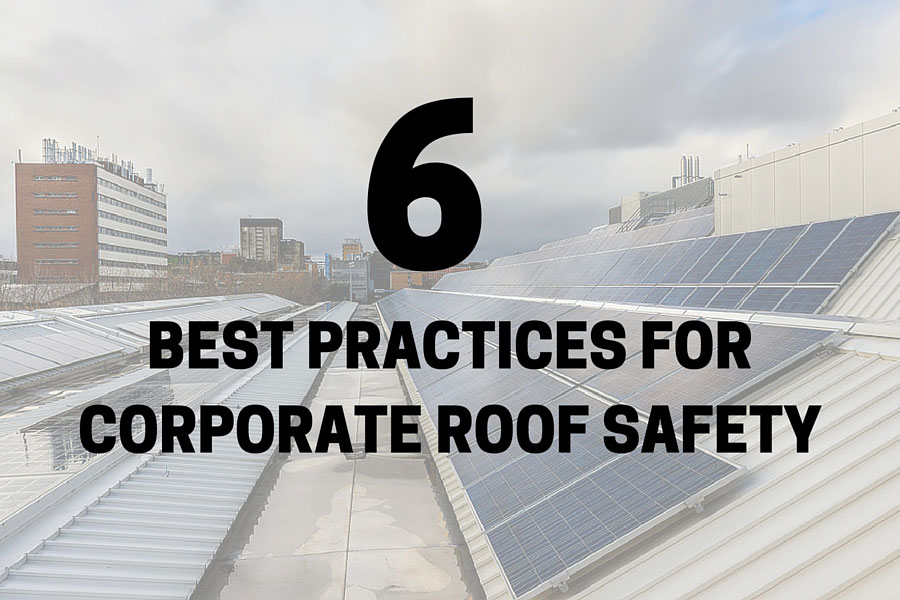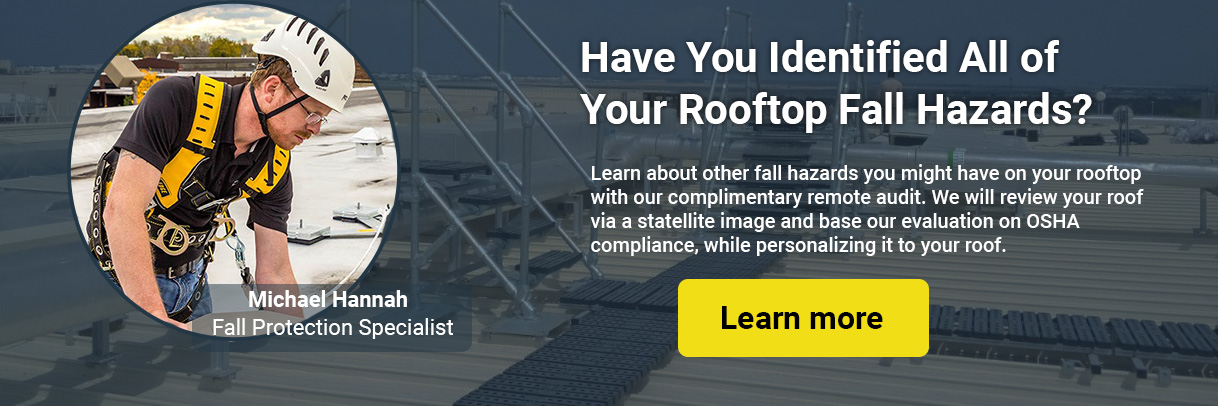6 Best Practices to Keep My Rooftop Workers Safe

There are obviously times when somebody will need to access the roof of your building or facility, whether it’s maintenance workers, contractors, or inspectors. As we’ve discussed, roofs are inherently dangerous, so we develop policies to direct the behaviors of our employees and contractors. One of the problems campuses or building-owners/managers face, though, is that rooftop work is often not visible to those who would be overseeing safety precautions. Tasks may consist of a small number of people going up alone to do something that could be as quick as changing a filter or inspecting a piece of hardware. In that small span of time, though, any number of things can happen. A processing facility could be venting dangerous fumes, for example, or even simpler, somebody could get themselves locked out. For these, and other reasons, more controls are needed besides safe working practices.
1.) The Buddy System
Never go on the roof alone. Plain and simple. Once on the roof, you are isolated. It is unlikely anybody else is just going to wander up there and find you if something goes wrong, so it’s best to always have somebody with you for safety. That way, if something happens to one of you, the other can retrieve or call for help. Not to mention, that second set of eyes may just notice something you didn’t – an unsafe condition that could have led to an incident. Never go at it alone.

2.) Communication and 15 Minute Safety Checks
Anybody going on the roof should have a means of communication with somebody inside the building. Radio, phone, or whatever else you decide, there should be something. This way help can be summoned if somebody cannot leave the roof to do so or if the people on the roof are locked out of the building. In addition, safety checks should be implemented. 15 minutes is frequent enough to help keep the workers safe yet still allow them to perform their work. Whenever somebody is on the roof, they should be required to check in at set intervals, so the people downstairs know that all is well.
Related Article: 10 Ways to Communicate Safety Standards Throughout Your Company
3.) Permitted Access
No rule is going to be enforceable if anybody can access the roof at any time. Having a permitting process allows you to ensure your rules are followed, allows you to ensure that somebody is on the receiving end of those check-ins, and allows you to do what’s necessary to make a roof safe for access. Returning to the processing facility example, there are obviously times when a person absolutely should not be allowed to be on the roof. If access is at-will, how do you know your contractor or maintenance employees aren’t going to go up there and expose themselves to something harmful?
Related Articles: How Does OSHA Define a Confined Space
4.) Scheduled Inspections
You may not realize it because your roof is just always there, but things happen and upkeep is needed. Rot can occur, causing soft spots, for example. Something can happen to a work platform causing it to become unsafe. Other things, such as roof mounted anchor points, require periodic inspections. On a set basis, somebody should be going to the roof (with a buddy) for the sole purpose of inspecting it. Should a deficiency be found, access to the roof - or the part of the roof with the problem - should be denied until the hazard has been abated. Document these inspections and either post them or some type of sign-off sheet so that people accessing the roof know when the most recent one has been performed. Set a rule that prohibits them from accessing the roof unless they see an inspection has been performed within a set amount of time.
5.) 15' Rule
Yes, in certain instances, roofers get to be 6’ from the edge with the proper precautions in place, but anybody else going on the roof should abide by the 15’ rule. This means that at no point should anybody go within 15’ of the edge of the roof (unless you have perimeter rails in place, the parapet is high enough to act like a rail, or the employee/contractor has other means of fall protection). Keep in mind, there is no distance from the edge of a roof that OSHA regulations deem safe without at the very least a warning line and safety monitor, but they have stated that if they cite an employer because the employees were on a roof but remained more than 15’ away from the edge, that they would cite it as a de minimis violation, meaning no monetary penalty would be attached. However, mark that 15’ line. Make sure your employees/contractors know where it is and do not, for any reason, cross it without proper fall protection.
Related Article: When is a Warning Line Sufficient Fall Protection
6.) Have Rooftop Rescue Plans
The part of a personal fall arrest system that often gets overlooked is probably overlooked for roof access as well. You’ve got all of these plans and precautions in place, but what are you going to do in the event that a rescue is needed? The rescue in question could be somebody falling from your roof in their personal fall arrest equipment, it could be somebody locked out, it could be somebody having a heart attack or some other accident that prevents them from being able to get themselves off the roof. How are you going to handle this? Do you have the necessary equipment in place to rescue your employee? Do you have a rescue squad that has both the necessary response time and equipment? Make sure you have a plan in place because when you need it, you’re going to want it to be solid.
Related Article: Importance of a Rescue Section in Your Fall Protection Plan
Maintenance on the roofs sometimes flies under the radar. It definitely does not receive as much scrutiny as rooftop work during construction or large rooftop repair projects/HVAC installation projects/etc. Do everything you can to monitor and control access to your roofs so that your people are kept safe and nobody is, literally, left out in the cold.


